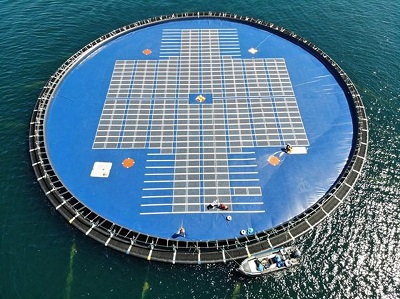 Friday, July 26, 2024
Friday, July 26, 2024  Friday, July 26, 2024
Friday, July 26, 2024 
As blogged on Forbes.com, Norway-based Ocean Sun was founded three years ago with the aim of disrupting the status quo in the solar industry. Its vision is to provide the technology that rapidly makes clean energy production the cheapest alternative to large populations around the world.
To achieve this, it has developed technology that will enable large-scale solar developments on coastal seawater, lakes, and reservoirs. The products are dubbed floaters, the flagship product has a diameter of 72m with an area of approximately 4000m2. They are based on utility type, dual-glass, crystalline silicon modules with a customized junction box, cables, and attachment features.
The modules can be rapidly and securely attached to the membrane enabling good thermal contact with the waterbody. The membrane itself is non-permeable and is a barrier against the waterbody, designed to withstand mechanical stress and sun exposure.
Because of the horizontal orientation of the modules and the solar elevation angle, the product is best suited within 45 degrees latitude. It is no surprise that the target areas are some of the hottest regions on the planet such as Australia, the Sahara Desert, and the Middle East, that blanket some of the most populated areas on the globe. “That was the starting point for Ocean Sun to have this in the back of our heads,” Arnt Emil Ingulstad, co-founder and CSO of Ocean Sun says. “According to data from the World Bank, there contain nearly 400,000 square kilometers of man-made reservoirs alone.
“If you utilize one percent of that area or we can maybe go as much as five percent, still a tiny portion of these vast areas of water surfaces, it adds up to a two-terawatt business. Two terawatts are approximately a $2 trillion business, assuming approximately one dollar per watt installed. We will probably see the prices dropping in the future, but as of today, it’s approximately 1:1, $1 dollar per watt.”
The technology that is currently serving this market is markedly different from Ocean ‘Sun’s approach in that it uses platoon-based cones. “These platoons are polyethylene plastic and crystalline solar modules, regular modules that you put on the rooftops,” Ingulstad says. “They are mounted on top of these to utilize the water surface. It is not really a robust solution for motion, and it’s also tough to install.”
For its solution, Ocean Sun turned to biomimicry. This is the imitation of the models, systems, and elements of nature to solve complex human problems. “We started looking at different ideas such as giant lilies, the Victoria amazonica,” Ingulstad explains. “They sit there performing photosynthesis. What we have come up with is something that looks similar. But we are conducting photovoltaics, which is basically the same principle. We have a thin membrane coating, and we try to collect the energy of the sunlight, not for photosynthesis, but for electricity production.
Keep reading this blog on Forbes.com
Watch the video and learn more about Construction Links Network – the peer-to-peer network sharing platform for the construction, building and design community.
Ideal for YOUR Press Releases | Project Updates | New Appointments | Awards & Milestones | Company News | New Products/Services | Brochures | Videos | Infographics | Blog Sharing | Events and More